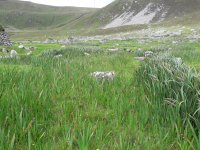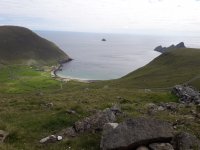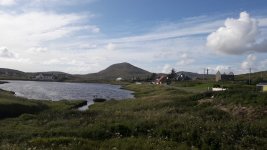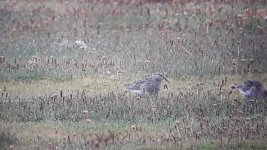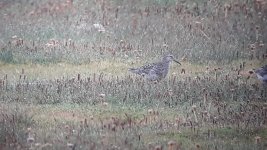dwatsonbirder
Well-known member
I’ve been very fortunate to travel to some interesting places over the years, but this trip was a first for me in two distinct ways - my first time in the Western Isles, and my first decent trip for work - yes, I really did get paid to visit St Kilda!
Saturday saw me leaving Gloucester early doors to take the train up to Edinburgh as the first leg of my journey. This went smoothly enough, and I enjoyed an afternoon and evening milling about the city doing touristy things. I have only visited Scotland once before in what felt like another lifetime ago, as a twentysomething attempting to make it in the music business, and I was delighted to revisit some of the places we hung out in when we were last here.
The following day saw me fly from Edinburgh to Stornoway, before taking a taxi the full length of Lewis and Harris down to Leverburgh. Coming in to land at Stornoway, the first species before the plane had even stopped was Hooded Crow, which although common in the north and west (and on the continent) was a species of interest to someone who has mainly lived in the south-west and east of England. Some of the fields near to the airport held foraging gulls (mainly Herring, but also a few Common and Lesser Black-backed) and a few Curlew. In amongst them were my first wild Rock Dove - technically a new bird for me if one discounts feral pigeon.
The journey to the B&B in Leverburgh was uneventful, and I enjoyed the spectacular scenery of the islands. Approaching the southern end of Harris, I noted the wide estuaries of Luskentyre and Northton, and made a mental note to pop back should I have any free time.
I spent a fair amount of the afternoon engaged in planning the logistics for my work - as well as the options for getting on and off St Kilda. I had a little time in the evening, so decided to wander around the village. There was a pleasant selection of common species, with a brood of Tufted duck and family party of Red breasted Merganser on the loch in front of the accommodation, whilst several Oystercatcher and Lapwing were present along the shoreline, along with three Greenshank and two Common Sandpiper. There were also a few passerines around, with the ubiquitous Meadow pipit and Stonechat, in addition to a good number of Wheatear - predominantly moulting juveniles. A mixed flock of finches contained both Siskin and Redpoll in addition to Greenfinch, Chaffinch and Goldfinch. A quick look in the bushes before returning for an earlish night produced three
and a single Sedge warbler - possibly migrants already filtering though. At the B&B there was one last treat in store, in the form of two White-tailed Eagle seen from the bedroom - not a bad end to the day!
Monday saw me up for 5am, and ready to board the boat out to St Kilda by 06:45. The journey out was fairly calm, and despite usually suffering with sea-sickness I managed to hold onto my breakfast… There were plenty of birds along the way, with another adult White-tailed Eagle perched up on some rocks offshore, and a smart Black Guillemot swimming about meters away from the boat. As we got further out, numbers of both Gannet and Puffin increased dramatically, with good numbers of Kittiwake and many Manx Shearwater also arching away over the tops of the waves. Eventually Boreray and Hirta appeared on the horizon, and having a fixed point eased my stomach a fair amount. A few Leach’s Petrel skittered over the waters surface, and Fulmar became increasingly frequent. A blue-ish blob in the water was apparently a Portuguese man-o-war, though could easily be mistaken for a plastic bag.
Approaching the island large rafts of auks and Gannets were present everywhere, with both Razorbill and Guillemot present with Puffin. Out in the bay were several Shag and a family group of Eider busily diving close to shore, whilst the rocks held a few Oystercatcher and Turnstone.
Safely on shore, I only had limited time to explore the island but the range of landbirds was limited; Rock dove, Meadow Pipit and Wheatear were present and correct, and the sole migrant was in the unlikely form of a Collared dove - apparently this had been present for a while. A few Snipe were flushed from various locations, whilst a couple of close calls involved Bonxie and Arctic Skua. These are familiar species for me, having observed individuals during seawatches (like many people) but seeing these birds on their breeding grounds was a totally different experience.
The Bonxies were obviously top of the food chain here, with all other species giving them a wide berth. I was lucky to observe a few social interactions between breeding birds (involving incredible aerial dogfights where pairs would fly several hundred meters into the air before stooping at one another) and also non-breeding and immature birds engaging in the more social activity of a good soak in the freshwater pools. Perhaps more impressive were the Arctic Skua, and I was fortunate to spend some time with a breeding pair guarding a fledgeling. This pair constituted a dark and intermediate morph, and allowed for extended observation at close range - often down to 5 or so meters without any distress.
With time pressing on, I decided to spend the last of my shore leave exploring the village. There were good numbers of Fulmar breeding within the walls of the ruins, whilst practically every iris bed held Snipe. A familiar scolding call gave away the presence of a most wanted little creature - the St Kilda Wren. The Wren led me on a merry dance for about 20 minutes, as they moved along the inside of the walls, only occasionally appearing in flight as they moved between cairns. Eventually one performed briefly on a wall, and I was surprised by how bulky and dark this subspecies was - almost like a ¾ sized Cetti’s warbler.
All too soon it was time to board and head back to Harris. The return journey was to be quite eventful, as a 3 - 4 meter swell had developed which made for less than ideal end to the day. An hour or so of viewing the gannetries around the outlying stacks demonstrated that unfortunately avian influenza had definitely began to permeate this remote population, with a fair number of dead or dying birds at the base of the cliffs. On a happier note, it seemed that there was still good feeding opportunities to be had, as the numbers of both Puffin and Gannet forming vast feeding parties was staggering - well into the tens of thousands. All of this activity attracted the attention of the local Bonxie population, and a few Gannet lost their catch. Although the Bonxies are top of the food chain on land and in the air, there was a much larger predator here, with a brief Minke Whale making an appearance - a new mammal for me. The remainder of the journey passes mostly without incident, however the choppy seas were impacting my fellow passengers; I too began to feel less than peachy about 2.5 in, however grabbing a brief nap seemed to help somewhat. The only birds noted on the return journey were much the same as on the way out; Manx Shearwater, Leach’s Petrel, Kittiwake, Fulmar and Arctic Tern, though a smart summer plumage Great Northern Diver briefly made an appearance as it steamed north up the coast.
Unfortunately the weather had turned back at Leverburgh, and persistent drizzle and a stiff variable wind did not give me much enthusiasm for birding, and after many hours at sea I decided that a shower, hot meal and early night was the more appealing option.
Having missed out on staying overnight on St Kilda, the next day was pretty much free time for me to catch up with some admin/explore the area and go birding. Despite the continuing poor weather conditions, I decided that a pre-breakfast wander around the village was in order, particularly in light of the south-easterly wind and rain. It may only just be August, but I was hopeful that these conditions may have dropped some new birds in. A wander along the main road added a few new passerines to the proceedings, with Song thrush (of the race hebridensis), Dunnock (of the race hebridium), Coal tit and Wren, in addition to two Willow and a Reed warbler in some sedge beds. A small waterbody held three Teal - as they were not present the previous day, these were presumably fresh in.
Despite the weather, I was feeling more enthused, and over breakfast planned my next move - a few hours birding at nearby Northton seemed a reasonable idea - the only sticking point being my 20kg backpack which I would have to carry around for the day.
The weather had not changed as I disembarked from the bus, but the scene was atmospheric; mountains enveloping a sweeping estuary half filled with icing sugar sand and tropical aquamarine waters, and best of all, quite a few birds. Lapwing and Oystercatcher were most obvious, whilst a calling Golden Plover remained unseen somewhere overhead in the murk. Out on the estuary were Redshank and small parties of calidrids, whilst a group of Black-tailed Godwit and Whimbrel fed amongst Hooded Crow and Starling on the machair.
I decided that a steady walk north towards the beach at Traigh na Cleavag was in order, and after quickly checking the beach (completely and utterly devoid of birds and with an onshore gale) the sheltered machair was the more appealing option. Family parties of Meadow Pipit, Stonechat and Wheatear were common, whilst further scrutiny of the machair resulted in yet more waders; a total of 23 Black-tailed Godwit, 5 each of Redshank and Turnstone, 3 Snipe, and singles of Common sandpiper and Greenshank. Eventually I found a point where I could get down onto the machair and gain a closer view of the estuary, so I left my backpack safely with some sheep and wandered toward the shoreline. Getting a little closer I realised that there was a flock of approximately 50 mixed small waders feeding about 100m, so I dropped to the floor and crawled on my belly towards them. A quick scan through them revealed a mixture of Ringed Plover and Dunlin, including a good number of adults still in their breeding finery. As I am currently living in an area where waders are at a premium, I decided to enjoy the birds at close quarters. Whilst scanning through the flock I picked up the back end of something that looked a bit more interesting, and after a few minutes of obscured views a fine adult Pectoral Sandpiper finally gave great scope views - a bit of a result as I’d hoped there was a chance of something interesting out here, and the species was an overdue “find tick” for me. It is worth a brief note here to highlight that the estuary is probably well worth regular checking, as its location at the very south western corner of Harris seems ideal for transatlantic waders - a quick check shows that Buff-breasted Sandpiper was found here in 2013 - either arriving directly in off the Atlantic, or trickling down the west coast of the Hebridies. Other waders were present in smaller numbers too, with a handful of Curlew and Sanderling and a fly-through Grey Plover also seen.
I collected my pack from my wooly guards, and slowly made my way back towards Northton where I’d arranged for a taxi to pick me up and take me to Stornoway, but not before one last treat - my fourth White-tailed Eagle in 3 days.
Arriving in Stornoway later that afternoon I decided to spend my last afternoon wandering around the estuary at Steinis. This did not prove to be as productive, but there were still a few birds of interest around to enjoy, with juvenile Greenshank and Whimbrel suggesting that perhaps local waders had fared a little better than some of the seabird populations. Other common waders were present, with Sanderling, Curlew, Redshank, Ringed Plover and Dunlin all present in small numbers. Out on the sands were a few gulls, with Herring and Lesser Black-backed joined by a couple of Greater Black-backed and a single Kittiwake. Singles of Kestrel and Buzzard were new for the trip, whilst the biggest surprise was a beautiful pale phase Arctic Skua harassing Arctic Terns in the estuary. The seas offshore held the ubqitious Gannet as well as a couple of smart Red-throated Diver.
It had been a very brief trip to only a handful of select locations across the three islands, however the rugged beauty of the area means that a return visit with more time to explore is certainly on the cards - though I cannot complain, how many people can say that all of the above is in a few days work? I can, but I am very, very lucky!
Saturday saw me leaving Gloucester early doors to take the train up to Edinburgh as the first leg of my journey. This went smoothly enough, and I enjoyed an afternoon and evening milling about the city doing touristy things. I have only visited Scotland once before in what felt like another lifetime ago, as a twentysomething attempting to make it in the music business, and I was delighted to revisit some of the places we hung out in when we were last here.
The following day saw me fly from Edinburgh to Stornoway, before taking a taxi the full length of Lewis and Harris down to Leverburgh. Coming in to land at Stornoway, the first species before the plane had even stopped was Hooded Crow, which although common in the north and west (and on the continent) was a species of interest to someone who has mainly lived in the south-west and east of England. Some of the fields near to the airport held foraging gulls (mainly Herring, but also a few Common and Lesser Black-backed) and a few Curlew. In amongst them were my first wild Rock Dove - technically a new bird for me if one discounts feral pigeon.
The journey to the B&B in Leverburgh was uneventful, and I enjoyed the spectacular scenery of the islands. Approaching the southern end of Harris, I noted the wide estuaries of Luskentyre and Northton, and made a mental note to pop back should I have any free time.
I spent a fair amount of the afternoon engaged in planning the logistics for my work - as well as the options for getting on and off St Kilda. I had a little time in the evening, so decided to wander around the village. There was a pleasant selection of common species, with a brood of Tufted duck and family party of Red breasted Merganser on the loch in front of the accommodation, whilst several Oystercatcher and Lapwing were present along the shoreline, along with three Greenshank and two Common Sandpiper. There were also a few passerines around, with the ubiquitous Meadow pipit and Stonechat, in addition to a good number of Wheatear - predominantly moulting juveniles. A mixed flock of finches contained both Siskin and Redpoll in addition to Greenfinch, Chaffinch and Goldfinch. A quick look in the bushes before returning for an earlish night produced three
and a single Sedge warbler - possibly migrants already filtering though. At the B&B there was one last treat in store, in the form of two White-tailed Eagle seen from the bedroom - not a bad end to the day!
Monday saw me up for 5am, and ready to board the boat out to St Kilda by 06:45. The journey out was fairly calm, and despite usually suffering with sea-sickness I managed to hold onto my breakfast… There were plenty of birds along the way, with another adult White-tailed Eagle perched up on some rocks offshore, and a smart Black Guillemot swimming about meters away from the boat. As we got further out, numbers of both Gannet and Puffin increased dramatically, with good numbers of Kittiwake and many Manx Shearwater also arching away over the tops of the waves. Eventually Boreray and Hirta appeared on the horizon, and having a fixed point eased my stomach a fair amount. A few Leach’s Petrel skittered over the waters surface, and Fulmar became increasingly frequent. A blue-ish blob in the water was apparently a Portuguese man-o-war, though could easily be mistaken for a plastic bag.
Approaching the island large rafts of auks and Gannets were present everywhere, with both Razorbill and Guillemot present with Puffin. Out in the bay were several Shag and a family group of Eider busily diving close to shore, whilst the rocks held a few Oystercatcher and Turnstone.
Safely on shore, I only had limited time to explore the island but the range of landbirds was limited; Rock dove, Meadow Pipit and Wheatear were present and correct, and the sole migrant was in the unlikely form of a Collared dove - apparently this had been present for a while. A few Snipe were flushed from various locations, whilst a couple of close calls involved Bonxie and Arctic Skua. These are familiar species for me, having observed individuals during seawatches (like many people) but seeing these birds on their breeding grounds was a totally different experience.
The Bonxies were obviously top of the food chain here, with all other species giving them a wide berth. I was lucky to observe a few social interactions between breeding birds (involving incredible aerial dogfights where pairs would fly several hundred meters into the air before stooping at one another) and also non-breeding and immature birds engaging in the more social activity of a good soak in the freshwater pools. Perhaps more impressive were the Arctic Skua, and I was fortunate to spend some time with a breeding pair guarding a fledgeling. This pair constituted a dark and intermediate morph, and allowed for extended observation at close range - often down to 5 or so meters without any distress.
With time pressing on, I decided to spend the last of my shore leave exploring the village. There were good numbers of Fulmar breeding within the walls of the ruins, whilst practically every iris bed held Snipe. A familiar scolding call gave away the presence of a most wanted little creature - the St Kilda Wren. The Wren led me on a merry dance for about 20 minutes, as they moved along the inside of the walls, only occasionally appearing in flight as they moved between cairns. Eventually one performed briefly on a wall, and I was surprised by how bulky and dark this subspecies was - almost like a ¾ sized Cetti’s warbler.
All too soon it was time to board and head back to Harris. The return journey was to be quite eventful, as a 3 - 4 meter swell had developed which made for less than ideal end to the day. An hour or so of viewing the gannetries around the outlying stacks demonstrated that unfortunately avian influenza had definitely began to permeate this remote population, with a fair number of dead or dying birds at the base of the cliffs. On a happier note, it seemed that there was still good feeding opportunities to be had, as the numbers of both Puffin and Gannet forming vast feeding parties was staggering - well into the tens of thousands. All of this activity attracted the attention of the local Bonxie population, and a few Gannet lost their catch. Although the Bonxies are top of the food chain on land and in the air, there was a much larger predator here, with a brief Minke Whale making an appearance - a new mammal for me. The remainder of the journey passes mostly without incident, however the choppy seas were impacting my fellow passengers; I too began to feel less than peachy about 2.5 in, however grabbing a brief nap seemed to help somewhat. The only birds noted on the return journey were much the same as on the way out; Manx Shearwater, Leach’s Petrel, Kittiwake, Fulmar and Arctic Tern, though a smart summer plumage Great Northern Diver briefly made an appearance as it steamed north up the coast.
Unfortunately the weather had turned back at Leverburgh, and persistent drizzle and a stiff variable wind did not give me much enthusiasm for birding, and after many hours at sea I decided that a shower, hot meal and early night was the more appealing option.
Having missed out on staying overnight on St Kilda, the next day was pretty much free time for me to catch up with some admin/explore the area and go birding. Despite the continuing poor weather conditions, I decided that a pre-breakfast wander around the village was in order, particularly in light of the south-easterly wind and rain. It may only just be August, but I was hopeful that these conditions may have dropped some new birds in. A wander along the main road added a few new passerines to the proceedings, with Song thrush (of the race hebridensis), Dunnock (of the race hebridium), Coal tit and Wren, in addition to two Willow and a Reed warbler in some sedge beds. A small waterbody held three Teal - as they were not present the previous day, these were presumably fresh in.
Despite the weather, I was feeling more enthused, and over breakfast planned my next move - a few hours birding at nearby Northton seemed a reasonable idea - the only sticking point being my 20kg backpack which I would have to carry around for the day.
The weather had not changed as I disembarked from the bus, but the scene was atmospheric; mountains enveloping a sweeping estuary half filled with icing sugar sand and tropical aquamarine waters, and best of all, quite a few birds. Lapwing and Oystercatcher were most obvious, whilst a calling Golden Plover remained unseen somewhere overhead in the murk. Out on the estuary were Redshank and small parties of calidrids, whilst a group of Black-tailed Godwit and Whimbrel fed amongst Hooded Crow and Starling on the machair.
I decided that a steady walk north towards the beach at Traigh na Cleavag was in order, and after quickly checking the beach (completely and utterly devoid of birds and with an onshore gale) the sheltered machair was the more appealing option. Family parties of Meadow Pipit, Stonechat and Wheatear were common, whilst further scrutiny of the machair resulted in yet more waders; a total of 23 Black-tailed Godwit, 5 each of Redshank and Turnstone, 3 Snipe, and singles of Common sandpiper and Greenshank. Eventually I found a point where I could get down onto the machair and gain a closer view of the estuary, so I left my backpack safely with some sheep and wandered toward the shoreline. Getting a little closer I realised that there was a flock of approximately 50 mixed small waders feeding about 100m, so I dropped to the floor and crawled on my belly towards them. A quick scan through them revealed a mixture of Ringed Plover and Dunlin, including a good number of adults still in their breeding finery. As I am currently living in an area where waders are at a premium, I decided to enjoy the birds at close quarters. Whilst scanning through the flock I picked up the back end of something that looked a bit more interesting, and after a few minutes of obscured views a fine adult Pectoral Sandpiper finally gave great scope views - a bit of a result as I’d hoped there was a chance of something interesting out here, and the species was an overdue “find tick” for me. It is worth a brief note here to highlight that the estuary is probably well worth regular checking, as its location at the very south western corner of Harris seems ideal for transatlantic waders - a quick check shows that Buff-breasted Sandpiper was found here in 2013 - either arriving directly in off the Atlantic, or trickling down the west coast of the Hebridies. Other waders were present in smaller numbers too, with a handful of Curlew and Sanderling and a fly-through Grey Plover also seen.
I collected my pack from my wooly guards, and slowly made my way back towards Northton where I’d arranged for a taxi to pick me up and take me to Stornoway, but not before one last treat - my fourth White-tailed Eagle in 3 days.
Arriving in Stornoway later that afternoon I decided to spend my last afternoon wandering around the estuary at Steinis. This did not prove to be as productive, but there were still a few birds of interest around to enjoy, with juvenile Greenshank and Whimbrel suggesting that perhaps local waders had fared a little better than some of the seabird populations. Other common waders were present, with Sanderling, Curlew, Redshank, Ringed Plover and Dunlin all present in small numbers. Out on the sands were a few gulls, with Herring and Lesser Black-backed joined by a couple of Greater Black-backed and a single Kittiwake. Singles of Kestrel and Buzzard were new for the trip, whilst the biggest surprise was a beautiful pale phase Arctic Skua harassing Arctic Terns in the estuary. The seas offshore held the ubqitious Gannet as well as a couple of smart Red-throated Diver.
It had been a very brief trip to only a handful of select locations across the three islands, however the rugged beauty of the area means that a return visit with more time to explore is certainly on the cards - though I cannot complain, how many people can say that all of the above is in a few days work? I can, but I am very, very lucky!




